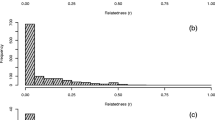Summary
Associations among female sperm whales, Physeter macrocephalus, and their dependent offspring, off the Galapagos Islands were studied between 1985 and 1989. The whales were found in groups containing about 23 individuals, with each individual having approximately 12 constant (over years) companions. These permanent units associated with one another for periods of ≅6.5 days, although the rate and duration of these associations seemed to vary between years, perhaps because of differences in the food supply. The principal function of the closed units may be care of the offspring, and units in the same general area may derive benefit from feeding in a coordinated manner.
Similar content being viewed by others
References
Arnbom T (1987) Individual identification of sperm whales. Rep Int Whal Commn 37:201–204
Arnbom T, Whitehead H (1989) Observations on the composition and behaviour of groups of female sperm whales near the Galápagos Islands. Can J Zool 67:1–7
Arnbom T, Papastavrou V, Weilgart LS, Whitehead H (1987) Sperm whales react to an attack by killer whales. J Mammal 68:450–453
Best PB (1979) Social organization in sperm whales, Physeter macrocephalus. In: Winn HE, Olla BL (eds) Behavior of marine animals, vol 3. Plenum Press, New York, pp 227–290
Caldwell DK, Caldwell MC, Rice DW (1966) Behavior of the sperm whale Physeter catodon L. In: Norris KS (ed) Whales, dolphins, and porpoises. University of California Press, Berkeley, pp 677–717
Caldwell MC, Caldwell DK (1966) Epimeletic (care-giving) behavior in Cetacea. In: Norris KS (ed) Whales, dolphins, and porpoises. University of California Press, Berkeley, pp 755–788
Gordon JCD (1987) Sperm whale groups and social behavior observed off Sri Lanka. Rep Int Whal Commn 37:205–217
Kanwisher JW, Ridgway SH (1983) The physiological ecology of whales and porpoises. Sci Am 248:111–121
Myers JP (1983) Space, time and the pattern of individual associations in a group-living species: sanderlings have no friends. Behav Ecol Sociobiol 12:129–134
Ohsumi S (1971) Some investigations on the school structure of sperm whale. Sci Rep Whales Res Inst 23:1–25
Sokal RR, Rohlf FJ (1981) Biometry. The principles and practice of statistics in biological research. 2nd edn. Freeman, San Francisco
Underwood R (1981) Companion preference in an eland herd. Afr J Ecol 19:341–354
Whitehead H (1989) Foraging formations of Galápagos sperm whales. Can J Zool 67:2131–2139
Whitehead H (1990) Computer-assisted individual identification of sperm whale flukes. Rep Int Whal Commn [Special issue] 12:71–77
Whitehead H, Arnbom T (1987) Social organization of sperm whales off the Galapagos Islands, February April 1985. Can J Zool 65:913–919
Whitehead H, Gordon J (1986) Methods of obtaining data for assessing and modelling sperm whale populations which do not depend on catches. Rep Int Whal Commn [Special issue] 8:149–166
Whitehead H, Waters S (1990) Social organization and population structure of sperm whales off the Galápagos Islands, Ecuador (1985 and 1987). Rep Int Whal Commn [Special issue] 12:249–257
Whitehead H, Waters S, Lyrholm T (1991) Population structure of female and immature sperm whales off the Galapagos Islands, Can J Fish Aquat Sci (in press)
Whitehead H, Weilgart L (1990) Click rates from sperm whales. J Acoust Soc Am 87:1798–1806
Whitehead H, Papastavrou V, Smith SC (1989a) Feeding success of sperm whales and sea-surface temperatures off the Galápagos Islands. Mar Ecol Prog Ser 53:201–203
Whitehead H, Weilgart L, Waters S (1989b) Seasonality of sperm whales off the Galápagos Islands, Ecuador. Rep Int Whal Commn 39:207–210
Wilkinson L (1987) SYSTAT: the system for statistics. SYSTAT Inc, Evanston, IL
Author information
Authors and Affiliations
Additional information
Offprint requests to: H. Whitehead
Rights and permissions
About this article
Cite this article
Whitehead, H., Waters, S. & Lyrholm, T. Social organization of female sperm whales and their offspring: constant companions and casual acquaintances. Behav Ecol Sociobiol 29, 385–389 (1991). https://doi.org/10.1007/BF00165964
Received:
Accepted:
Issue Date:
DOI: https://doi.org/10.1007/BF00165964




